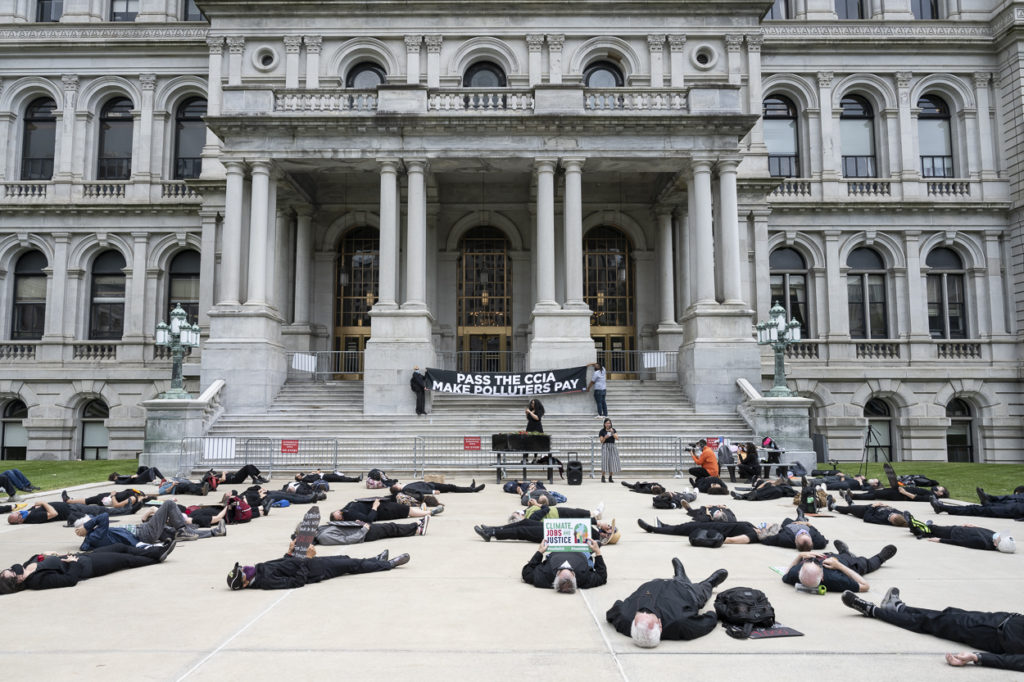The reports from the field observations on climate are returning with ever worsening reports, as predicted. Heat absorption, the Arctic and Antarctica, mounting land degradation tallies are ticking upward, which again, were explicated in the climate models. Last week, Greenpeace released a report on an Exxon lobbyist who was tricked in admitting fierce lobbying behind the scenes and the corruption of key senators to prevent climate change legislation in the U.S. Senate, as per the Tobacco playbook of fifty years ago. The interview also shows the campaign to prevent climate change legislation is shifting into another, well-documented gear: “Give up,†certain no-name writers press. “Give up and go home; enjoy these better days while you have them.
The new task at hand is not defending the veracity of the data. The evidence proving climate change has swayed approximately 70 percent of the American population according to the latest surveys. Climate Denialism continues to lose adherents as the effects of global warming are experienced by more people with no alternate explanations possible. Scientists and activists are winning the first battle of denialism, but the fossil fuel industry has already moved on.
More than one set of delaying tactics are described in the earlier Tobacco Industry playbook, which goes back fifty years. Thwarting legislation is a multi-pronged approach requiring several different strategies, and different types of timing. As denialism tapers off, the fossil fuel industry is pivoting to two other methodologies: denigration and delay. As the Tobacco Industry demonstrated, these tactics work, delaying anti-tobacco legislation and litigation for fifty years.
On the denial track, we have passed through most of the “denial that the problem exists,†although there is still funding flowing to professional deniers such as the Heartland Institute. Thirty percent of Americans still believe that climate change does not exist, that it is a hoax, or that its existence and effects are overblown. These public relations campaigns have been unusually effective.
One of the most effective components happening now is the half-step campaign. The half-step is the acknowledgement by the industry that climate change exists. Such pronouncements are hailed as great milestones and proof the fossil fuel industry is finally paying attention to the threat of climate change. In truth, they have been paying close attention since the late 1970’s according to their own internal studies and documents. With this half-step announcement, the industry pivots to a stance of non-engagement. In the same breath that they confirm climate change is real, they deny that climate change is a problem. No one needs to act because climate change is benign.
Continuing further down the denial track, the fossil fuel industry pushes two specific ideas. The first project is to deny that the fossil fuel industry is the cause. They point fingers at cows, governments, corporate agriculture and most effectively, at ordinary people. There are kernels of truth in their accusations, but not even close to a whole, accurate truth. Just enough truth to make the accusations appear tenable is part of the strategy.
Their claim is if everyone would take personal responsibility for their contributions to climate change, the crisis would be solved. The argument is demonstrably false, but it accomplishes its true goal of shifting the conversation away from fossil fuels. Other permutations include “we’re trying, why aren’t you†or “we’re doing our part, everyone else is the problem.†Most insidious of all is the claim “not to worry, a technological is fix is coming to save us.†There is no technology in a production pipeline to address climate change now.
The second idea, which has not emerged fully into blossom yet, is to deny that we can solve climate change. The climate is complicated involving ocean currents under the ocean to carbon accretion in the upper layers of the atmosphere, and no one can really understand all of it. Even the climate scientists do not have all the answers, they claim. The fossil fuel industry will humbly profess the problems are too complicated to solve at this time, but they promise to continue studying the issue.
Delaying action on climate change is the arena in which doomerism is actively pushed. Two types of delay are in play, but both are concerned with politics. The most expensive element in the industry’s push to stop legislation is lobbying. They make donations to politicians and political campaigns. If they identify a vulnerable legislator, they fund campaigns to raise a primary challenger or fund the candidate who supports their industry in the full election. They have lobbyists in every state, working with municipal, county, and state legislators and with the regulatory agencies. They fund think tanks and institutes whose sole purpose is to stop climate change legislation from being passed. They have been successful.
However, constituents vote, and they lobby too. The power of the electorate is formidable when it is engaged and their aggregated votes and demands of legislators are effective; they are a deep challenge to the fossil fuel industry despite their billions of spent dollars. To delay the electorate, they hire firms to prevent aggregating into large coalitions. These firms target individuals who are aggregators of public concern including scientists, teachers, clergy, pundits, environmental groups, and informed politicians. They also attempt to discourage people from taking up the cause using media, social media, print campaigns, and any other method they think may work. They have money to spend.
The promotion of doomerism, the fear that it is too late to save the planet and that all is lost, is a pernicious delaying tactic. The voice of doom sends the message that nothing can be done. The concerned citizen who learns this terrible truth should go home and close their doors. They should use their energy to live the best life they can while they can because all is lost. They should give up the fight because the battle is already lost; we are too late.
“I came to view with despair all the gains I had made under the sun,†Kohelet records in the Book of Ecclesiastes, falling into a funk of futility despite his recounted successes. Doomerism is the latest expression of well-attested despair. Despair is crippling, leading to withdrawal from the world and from everything that gives life meaning and worth; it is an affliction.
As a tool to discourage people from taking community and political action, despair is potent. From young adults through every decade through the elder years, despondency is a cruel and crippling reality to the vulnerable. “No sickness like despair†declared Israel Salanter Lipkin centuries ago.
To the power hungry and cynical, promoting despair in the opposition or in the population is a documented path to success. Take the fight out of one’s enemies and they will not bother to raise their arms in defense, much less raise a counterattack. Peeling off parts of the population who would care about climate change and neutralizing them is an appealing strategy. The promotion of doomerism lately demonstrates the effort is well underway.
Across the globe in almost every generation, people have risen to overcome their despair and move forward. Despair is an ancient problem, which is found in the writings of every religious tradition. St. Francis of Assisi encouraged his fellows, declaring that hope is the antidote to despair. The ancient Jewish traditions argue that despair is the loss of hope. The Buddhist teachings direct the practitioner to lean into the despair, using the pain as a lever to raise others out of their despair.
Despair is real and its presence is a necessary component of our response to climate change. Hopelessness reminds us of all that is precious to us, from our fellow human beings to the planet that sustains us all. The suffering of human beings from global warming is cataloged as an evil in the Western religious traditions and as avoidable suffering in the Eastern traditions. Both traditions are on point, signaling why despair over the climate is painful and even crippling at times.
The toxic nature of despair is not a foregone conclusion. The presence of despair is a moment of self-revelation, an insight that all is not right. Anguish is an opportunity to examine the causes of our pain and to challenge our lack of hope. The propaganda surrounding the push of climate doomerism is an attempt to extinguish the presence of hope. Hope is the target to be eliminated as the industry pushes against change.
Despondency need not be a stumbling block. The power of this human sentiment is available to all people, and the power can be a great source of motivation. Without this element of threatened hopelessness, the fights for climate change legislation would be an academic one or the work of a professional gunslinger who earns a paycheck lobbying politicians. Despair is an engine that galvanizes the religious soul, that bothers the people on the sidelines who await a goad to act. Despair is the call to action. The presence of despair informs us that this battle to save the planet is the movement of peoples against the lust for wealth and power. As climate change is global, the gathering to force change on the fossil fuel industry is worldwide, and all of this gathering, each and every individual joining the cause, begins with despair.
As one organizer declares in her email signature, “From pain, to protest, to power.†Despair is not a conclusion, but a beginning point. From anguish and hopelessness, the only path is upward.


